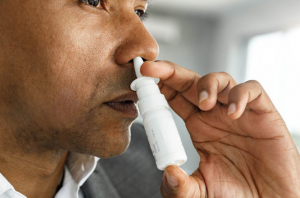How does nasal mist help in fighting stuffy nose?
2021-11-22 By hqt

2021-11-22 By hqt
The most important of them are:
The bad news first: Unfortunately no. Certain measures cannot be taken any quicker to get rid of a cold that occurs as part of a cold. You have to wait until the cold is cured.
The body simply needs a certain amount of time to fight and eradicate the viruses that cause colds. Once the pathogens are out of the body, the nasal congestion problem automatically resolves itself.
In contrast to a cold, unfortunately, the time with hay fever and sinusitis does not heal anything. Going to the doctor is urgently recommended so that they can determine the causes and prescribe the appropriate therapy.
But now the good news: You can very effectively alleviate the nasal mist unpleasant symptoms of a cold, such as a runny or blocked nose, the urge to sneeze and the formation of crusts!
No matter what the cause of the runny nose, these 6 tips can help you to get the stuffy nose free again.
For cassette pump that have a built-in pump, an additional pump is needed only in a small number of cases. The main pump does not provide condensate removal due to too large a distance or a large difference in the heights of the inhaling pump and the place where the condensate is drained.
A pump of any design and required performance is suitable for it. The pump can place in any convenient place behind the raised ceiling.

The amount of condensation produced by the inhaling pump depends on the cooling capacity of the Nasal mist, the temperature and humidity of the processed air.
Approximately the amount of condensate is 0.5–0.8 l / h per 1 kW of cooling capacity.
For example, if the refrigerating capacity of the inhaling pump is 3 kW, then the volume of condensate is approximately 1.5–2.4 l / h.
The pump performance must be at least equal to the amount of condensate produced by the inhaling pump. Performance is one of the most important characteristics of the pump and must be indicated in the technical documentation for the pump.
Currently, drainage pumps are produced by several manufacturers. Each company produces several options for drainage pumps, different in design, performance and installation method.
However, some common features of drainage pumps from different manufacturers make it possible to divide them into groups. This division allows you to determine the preferred area of use for a particular drainage pump.

The scope of such pumps is limited by the possibility of installing them inside the inhaling pump. Typically these are ducted inhaling pumps, small AHUs and dehumidifiers. However, Pumps are produced with a productivity from 5 to 170 l / h. Installation options for a built-in pump are shown in Figure 2.
These Nasal mist have a small storage tank with a level sensor. Also, the design of the tank is such that it can install both inside the drainage tank and on the outlet drain pipe or hose.
The control unit and the pump are housed in a separate unit, which is connected to the reservoir by a short, usually 1–2 m, flexible pipe and a wire from a level sensor installed in the storage reservoir. Such a separate design of the pump allows you to take out the largest parts of the pump outside the indoor unit of the inhaling pump.
These Nasal mist, as a rule, have a sufficiently large storage tank, into which drainage water flows by gravity, that is, it is poured. Also, the pump is made in the form of one unit, which includes a reservoir with a level sensor, a control device and a water pump.
The pump is located below the drainage bath and has a large dimension. Also, the capacity of the filling pumps is from 80 to 1500 l / h when the drainage water is supply to a height of 3 m. The scope of the filling pumps is refrigeration systems, high-power pump or a group of inhaling pumps.
A feature of Nasal mist is drainage water lifting to a sufficiently large (up to 15m) height. This feature of the pump is providing a special peristaltic pump. The performance of such pumps is small (up to 10 liters). Peristaltic pumps differ in the way they are operated. The simplest way is a signal to turn on the inhaling pump compressor.
Conclusion
Another control method is a signal from a temperature sensor installed on the evaporator of the inhaling pump. There is also some symbiosis between a peristaltic pump and a storage tank from a split pump with a level sensor. The area of application of peristaltic pumps is refrigeration systems of small capacity.
Bona's mission is to provide the pharmaceutical industry with innovative, distinctive products, quality services, thereby contributing to the improvement of human health worldwide.